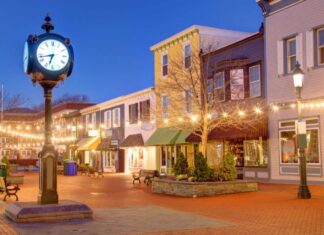
Voorhees resident Mary Lamielle reflects on decades of environmental and political advocacy.

Strolling past lawns throughout Voorhees Township, one may find “Pesticide Free Zone” signs planted firmly in garden beds.
The indications represent much more than mercy for insects but allude to a condition experienced by up to one-third of Americans reacting to low-level everyday exposures, according to various studies.
The signage is also a testimony to the advocacies of Voorhees resident Mary Lamielle, executive director of the National Center for Environmental Health Strategies.
In 1979, Lamielle, who has lived along Rural Avenue her whole life, became disabled with environmental sensitivities, a condition in which health is impacted after exposure to foods, chemicals, pesticides, molds, electromagnetic fields and radio frequencies from wireless technologies, according to the Environmental Health Association of British Columbia.
People struggling from environmental sensitivities are disabled by both indoor and outdoor environmental elements. From the electromagnetic spectrum to fragrances, patients experience debilitating reactions to low-level chemical, electrical and other exposures.
“Just because a product is on the market doesn’t mean it’s safe,” Lamielle said. “Trust your body.”
Lamielle became disabled from exposure to a malfunctioning sewage treatment plant, extensive household remodeling and the application of the pesticide chlorpyrifos into her bedroom wall.
In light of her illness, Lamielle started community advocacy from her home, which eventually evolved into statewide efforts.
In particular, she wrote letters, made phone calls and met with an agency official from the state health department at her home with other patients in an effort to convince the state to commission the report “Chemical Sensitivity: A Report to the New Jersey State Department of Health,” which won the World Health Organization’s Macedo Award.
What started as undertakings in her home gradually laid the foundation for the National Center for Environmental Health Strategies, a federal effort and organization to protect the public health and improve the lives of people injured or disabled by chemical and environmental exposures.
“It happened out of necessity,” Lamielle said.
Over the past 35 years, Lamielle and the NCEHS participated in a scope of political and environmental landmark accomplishments on local, state and federal levels.
The nonprofit initiated the landmark New Jersey Study of Chemical Sensitivity, which later became a book titled “Chemical Exposures: Low Levels and High Stakes.”
NCEHS worked to secure the first congressional funding for research on chemical sensitivities. In 1989, the nonprofit provided the first congressional testimony regarding chemical sensitivities on the Indoor Air Quality Act. It also worked to get a research requirement on chemical sensitivities through the Indoor Air Quality Act.
“I’ve essentially tried to educate the public, professionals, federal agencies on what this condition is,” Lamielle said.
On a state level, Lamielle contributed to a plethora of pesticide-related regulations.
Along with working on a committee to develop the New Jersey Pesticide Posting and Notification Regulations, locally, she proposed the adoption of the Voorhees Pesticide Reduction Policy, leading to pesticide-free parks throughout Voorhees, which are distinguished with “Pesticide Free Zone” signs.
She also advocated for passage of the New Jersey School Integrated Pest Management Act of 2002.
The NCEHS continues to fight for a proposed Interagency Committee on Environmental Sensitivities, which would establish a comprehensive group committed to examining research, policy development, patient support and public education for the affected population.
In March 2011, the U.S. Access Board supported the nonprofit’s proposal to create an Interagency Committee. Although meetings have been held since, no action has taken place.
Just last month, Lamielle once again urged the U.S. Access Board to act on its previous commitment to join with other federal partners in establishing an interagency Committee on Environmental Sensitivities.
Despite decades of campaigning for the research and recognition of environmental sensitivities, the disease presents a particular paradox.
“You can’t be a part of the process, because the process is exclusionary,” Lamielle said.
Ironically, along Lamielle’s paths to advocacy, she has found herself hindered by the very conditions she’s addressing.
Often, meetings or presentations are held in town halls, hotels and other buildings containing toxins such as building materials and cleaning agents. Even another attendee’s perfume can trigger a series of reactions.
“As a disabled group, we’re not likely to be demanding our rights on the steps of the Capitol due to our health problems, most of us are too sick from chronic exposures and disability,” Lamielle said. “Even more noteworthy because public and commercial buildings are not accessible due to significant indoor and outdoor pollutants.”
Those interested in additional information on NCEHS or those who would like to volunteer or intern at the Center should contact marylamielle@ncehs.org or leave a message at (856) 429–5358.










